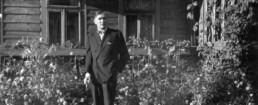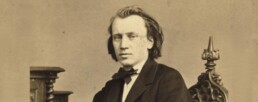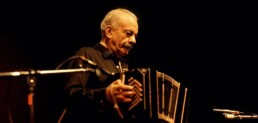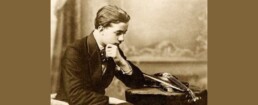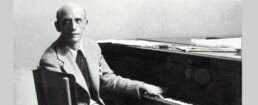Musical promenades at the museums - Myths
Where, or rather how, do unruly romantic passion, level-headed Apollonian lyricism and dazzling musical virtuosity exist side by side? However mutually contradictory the above may seem, in the hands of the great composers they can coexist and interact in the most unexpected places, riveting audiences in the process. But I'm sure you'll experience that for yourselves in this concert featuring the violinist Phaedon Miliadis and the pianist Thodoris Iosifidis.
The free man
Anyone who fell in love with Richard Bach's novel Jonathan Livingston Seagull would be well advised to listen to the new work by Christos Papageorgiou which was inspired by it. Another free and revolutionary hero of world literature, Nietzsche's Zarathustra, provided the imaginative spark Richard Strauss needed to compose one of the most important symphonic works of Late Romanticism. The former artistic director of the ASO, Vasilis Christopoulos, returns to the podium to conduct the rapidly up-and-coming Czech violinist Jan Mráček in Brahms' Concerto.
Richard Galliano with the A.S.O.
We associate the sweet, sensual sound of the bandoneon with the music of Latin America and the work of Piazzolla, in particular. Richard Galliano, for many the world's finest virtuoso on the accordion and the bandoneon, joins the Athens State Orchestra in his dual capacity as composer and soloist to provide Athenian music-lovers with a unique opportunity to enjoy the singular timbre of the accordion and the bandoneon live and in a solo role.
Tribute to Skalkottas’ Year
Another little-known symphonic masterpiece wrought by the musical genius of Nikos Skalkottas, another priceless musical gem of Greek music put back in the spotlight. The Athens State Orchestra is delighted and honoured to welcome our beloved, internationally acknowledged Greek pianist Dimitris Toufexis, interpreting the Rachmaninoff's Piano Concerto no. 2, one of the most popular pieces of all times.
Musical promenades at the museums - Piano Trio
Every work in this concert has been influenced to a greater or lesser degree by traditional musical idioms. The finale of Haydn's Trio is imbued with the fleet-footed feel of gypsy music, while the mournful atmosphere of the Slavic dumka weighs heavy upon the entire Dvořák's Trio. The concert closes with the great Argentine composer Astor Piazzolla's Four Seasons, a piece underpinned—like all his music—by the sensual rhythm of the tango.
Music for/from Britain
Our every collaboration with the experienced German conductor Christoph Poppen turns out to be an unforgettable experience for the musicians and the audience alike! In this, his latest appearance with the ASO, he will be conducting Mendelssohn's melancholy "Scottish" Symphony along with the première of a new symphonic work by Dimitris Papadimitriou. The internationally acclaimed violaist Tatiana Mazurenco will play Walton's demanding Viola Concerto, which was prevented from being performed last year by force of circumstance.
Side by side 2019
Being fully aware that the education of our future audience but also the training of young music students are matters of the highest importance for a historical artistic institution, members of the Athens State Orchestra make the most of each opportunity to stand by young people and to impart their love of making music. Under this perspective, the Orchestra’s collaboration with the College Symphony Orchestra, the Hellenic-American Educational Foundation’s Orchestra, is for everyone an ideal timing of a first-class opportunity for coexistence among professional musicians and young music students. For the first, the youngsters’ freshness and enthusiasm is a welcome source of energy and spirit, while the later learn in action the demands but also the joy of the disciplined musical collaboration within a professional symphonic orchestra.
After the opening of the concert by the Hellenic-American Educational Foundation’s Choir who will interpret four popular songs, members of both orchestras will perform “side by side” a rich programme that is covering a wide stylistic spectrum.
The College Symphony Orchestra together with the Athens State Orchestra interprets pieces composed by Zimmer, Vivaldi, Handel, Sibelius and Jenkins.
The Athens State Orchestra interprets Beethoven's Symphony no. 7.
Musical promenades at the Museums - Music for Brass Trio from all over the world
Three vibrant and artistically curious ASO musicians present us with an interesting combination of instruments that is only rarely heard in Greece: the French horn, trumpet and trombone of the brass trio. Applying their knowledge and love of music, they have selected some of the most strikingly original works of the 20th century—works everyone deserves to hear and enjoy live.
Mahler Cycle VIII
Continuing our journey through the music of the beloved Austrian symphonist, Gustav Mahler, we reach his towering Second Symphony. Its sensitive music works both as an agonized depiction of earthly tensions both within us and in the world, and as an expression of an ardent desire to access the deeper, metaphysical essence of existence. For Mahler, over and above its religious meanings, the Resurrection reveals itself primarily as the experience of an all-consuming Love...
Skalkottas and his contemporaries II
Nikos Skalkottas' celebrated Greek Dances and Dimitris Mitropoulos' revolutionary and angular Concerto Grosso bookend one of the most impressive violin concertos of recent years, which was composed by the well-known American composer of Greek descent, George Tsontakis. The solo part will be interpreted by the distinguished violinist Antonis Sousamoglou, while the orchestra will be conducted by the multifaceted maestro and academic, Leon Botstein, making his Athens State Orchestra debut.

